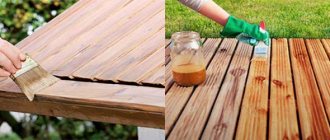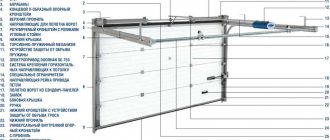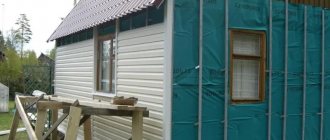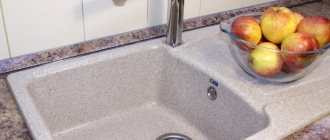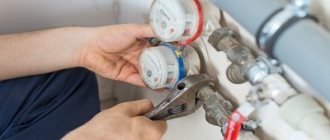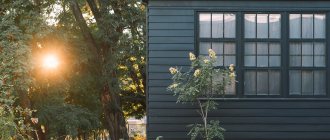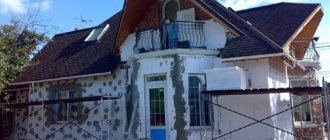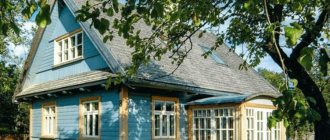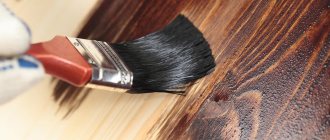Modern facing material will protect and decorate the facade of a wooden building
Have you decided to renovate your country house, but don’t know what material to choose for the exterior? Pay attention to the siding, which is installed on the walls according to the curtain wall system. This technology has a huge number of advantages and can be easily implemented on any wall base material. In our article we will tell you how to sheathe a wooden house with siding, which panels are suitable for this and what should be taken into account before proceeding with installation.
Selection of materials
Before covering a wooden house with siding, it is worth studying basic information about the types of material. The following brief description can be given:
- plastic siding is the cheapest, most practical, but is afraid of mechanical stress;
- metal - strong and durable, but needs protection from rust (does not apply to aluminum);
- wooden - fits perfectly into the properties of a wooden house and will be the best option, but buyers may be put off by the price;
- fiber cement - not so popular, not flammable, durable, but difficult to install and has a large mass.
Next, you need to select the sheathing material. It can be made of wood or light metal profile. Installing metal sheathing is easier on uneven ground. Such a frame will be strong and reliable.
But covering a wooden house with siding on a wooden frame yourself will cost less. You also don’t have to worry about protecting the wall and sheathing at the points of contact with the element, since they are made of material with similar properties. When purchasing and selecting wood for sheathing, it is important to ensure that the wood is:
- without delaminations;
- without deformation;
- without bluish spots or signs of rot.
Before starting work, the wooden sheathing is impregnated with fire retardants and antiseptics. The former increase resistance to fire, and the latter to mold and mildew.
Metal siding
It is rarely used for cladding, since such siding for a house made of timber has more disadvantages than advantages. Significant insulation and waterproofing will be required - metal becomes a bridge of cold at low temperatures and condensation that occurs. In addition, in bad weather, owners simply will not be able to sleep when hail or rain rumbles against the cladding - sound insulation in the form of cotton mats will not help.
Don’t forget about corrosion - when cutting material, exposed joints must be treated with a special silicone lubricant so that rust does not spread over the entire surface. This type of siding is mainly used to decorate premises intended for household needs.
Frame installation
Finishing a wooden house begins with the installation of guides. The vast majority of siding requires the sheathing to be mounted vertically. Its pitch is selected depending on the insulation. The clear distance between the guides should be a couple of centimeters less than the width of the mineral wool. For polystyrene, the distance is selected exactly to match the width.
To make wooden sheathing, bars measuring 40x40 mm or 50x80 mm are most often taken. When using the metal version, you will need a set of special profiles of different sections.
The frame slats are installed in increments of 40 cm, incl. around openings. There should not be any slats at the very bottom
Nails or self-tapping screws are used to attach the frame to a wooden wall. The former must have an anti-corrosion coating made of zinc or aluminum. Before fastening the sheathing with a construction stele, a vapor barrier is installed. To do this, you can use regular plastic film, but it is better to buy a special vapor barrier membrane. The choice of materials in a wooden house should be taken extremely responsibly. It is not recommended to use those that will block the movement of air through the walls. For this reason, membrane is better than film.
When finishing a wooden house with siding, the vapor barrier is attached with an overlap of 10 cm. Before starting work, it is recommended to read the manufacturer’s instructions. Next, the guides are attached at the required increments, starting installation from the corners. Levelness is checked using a building level.
Insulation is placed between the sheathing guides. It is better if it is mineral wool due to its good air permeability. A layer of waterproofing and wind protection needs to be fixed on top of the wool. The best option would be modern vapor diffusion (not to be confused with vapor barrier) windproof membranes.
Equipment
A set of siding panels for cladding the facade of a house should be selected depending on their width and wall area.
The complete set of wall siding includes:
- panels directly;
- internal as well as external corners;
- the starting profile located first from the base;
- J-, H-, or T-profile;
- J-chamfer;
- casing 75, 89 mm;
- solid soffit;
- window profile;
- low tide;
- finishing profile.
Additional decorative elements help make the outside of the house look complete and beautiful.
Securing the starting J-profile
Cladding a house with siding with your own hands at the next stage involves the following procedure:
- Finding the lowest point on the sheathing using a level. It is necessary to measure 50 cm upward from this point and mark this point (for example, with a loosely screwed screw).
- Sequential marking of lines with self-tapping screws along the perimeter of the building.
- Pull the cord at a distance of 50 cm from the bottom along the screws.
- Marking the location of corner profiles on slats. The profile is laid to the corner, its edges are marked.
- Fixing the first starting profile along a rope with a gap of 6 mm from the future border of the corner profile.
- Fastening the remaining starting strips with a gap between adjacent ones equal to 10-12 mm for thermal expansion.
- Checking the level of the starting bars.
Installation of the starting profile
The profile must be mounted perfectly level. If there are deviations at this stage, the entire siding of the wooden house will be distorted.
Execution of work
After selecting and purchasing materials, they begin to insulate and cover the house with siding. If all stages are followed exactly, the work will not take much time.
Preparing the base
The whole process is easy to do with your own hands. The algorithm is as follows:
Treatment with complex primer is considered a mandatory procedure during preparation
Further work is carried out only after the coating has completely dried.
Important! It is necessary to insulate and sheathe a house with siding in warm weather with a humidity of no more than 65–70%.
Laying vapor barrier and installing frame
Finishing a residential building involves creating sheathing; for this purpose, when working with timber foundations, it is recommended to use wooden materials.
Frame creation process:
In wooden houses, it is better to use wooden beams as lathing for insulation.
To ensure reliable insulation, it is recommended to carefully fill the gaps that appear between the frame and the wall with foam.
Installation of hydro- and thermal insulation
The material is laid as follows:
If it is necessary to create a ventilation gap, then slats of the required cross-section are placed on top of the racks.
Corner profiles
Before you attach the siding, you will need to install the corner strips. They can be for external and internal corners. The first ones are mounted in this order:
- Marking the location of the edges of the spotlights.
- Attaching the guide to the corner of the building. There should be a gap of 3 mm between the profile and the soffit (roof). The lower border of the profile is located 6 mm below the border of the starting profile. The plank is secured with self-tapping screws in the upper part.
- Check verticality using a building level or plumb line. Adjust the location if necessary. Fastening the bottom and middle with self-tapping screws. Fasteners do not need to be provided too often.
Installation of a corner profile
If it is necessary to join the profile in height, the joining place is located at the same level in all corners of the building. The joining is done with an overlap. The part with holes for fastening the top panel is cut so that there is a gap of 9 mm between it and the same part of the bottom panel. Instead of a corner profile, when installing siding on a wooden house, you are allowed to use two starter ones.
Step-by-step instructions for installing profiles for internal corners look almost the same. But in this case, other strips are used.
Options for interior corner solutions
Preparing the surface for laying thermal insulation
Insulation of a house can be done at any time of the year.
You can carry out work on laying thermal insulation in any season. Only if vinyl siding is used as a finishing material, installation of insulation is carried out at a temperature of at least 10 degrees Celsius, since vinyl becomes very brittle and brittle in winter.
Before laying thermal insulation, there is no need to carry out special preparation of the wall surface, since all work will be carried out with the installation of a special lathing that will perfectly mask all irregularities and deformations.
Before starting work on thermal insulation of walls, it is necessary to remove drainpipes, window sills, window shutters, lamps, as well as tree branches or plants that may interfere with installation.
Opening frames
When securing the siding with your own hands with insulation, you may encounter difficulties at this stage of the work. The fastening in this case depends on how the opening is located relative to the plane of the outer wall: flush or recessed.
Waterproofing is required around windows
In case of flush openings, the façade should be finished in the following order:
- Performing waterproofing of openings.
- Fastening trims or J-type profiles. For each opening you need to use 4 platbands: 2 horizontal and 2 vertical.
- The profiles are connected to each other. A bridge cut is made on each side of the upper profile. They are bent down to divert precipitation into the lower profile. Areas of material on the vertical strips that prevent connection with the upper ones should be removed. The side and top profiles are connected so that the bridges are inside.
- The operations are repeated with the lower casing. But in this case the bridges are cut in the side elements.
Installing profiles around windows
To work with recessed openings, you need to follow the same recommendations as in the previous case. The differences lie in the use of profiles of different shapes.
Wooden siding - lining, block house, imitation timber
Beautiful and environmentally friendly. However, at the same time, the owners receive a very capricious cladding - houses made of timber with siding of this type also react sharply to external manifestations - moisture, biological damage, shrinkage - just like ordinary wood.
You will have to regularly treat the sheathing for protection from rot, fire and rodents.
The presentability of the houses is high, but the cost of such cladding, if it is a European standard, is high. Other categories will have even more disadvantages.
The best finishing with clapboard and imitation wood looks indoors when the outer walls are made of laminated veneer lumber.
Installing the first panel
Work should begin on the side of the building that is least noticeable. In this case, there is an opportunity to practice and get better. The first panel is first inserted into the corner profile and into the locking connection of the starting one, snapped into place. A 6 mm gap must be left between the bottom of the lock and the first siding element to compensate for thermal expansion.
Correct fastening of slats
The next step is to fix the first cladding strip to the sheathing. Self-tapping screws are used for this. The siding has elongated holes for fasteners; the self-tapping screw must be placed in the middle of this hole. All fasteners are placed strictly perpendicular to the wall surface. The screws do not tighten too much; this is necessary to prevent deformation and damage due to thermal expansion.
Types of siding for a log house - advantages and disadvantages
Usually, derivatives of PVC and metal are used for external cladding - ondulin, corrugated sheets. Siding fits easily onto a log house. Also types of siding include wooden lining and block house.
The latter imitates a log, which significantly increases the presentability of the house. The advantages and disadvantages of each type are described below to facilitate the choice of raw materials for owners who are ignorant in this matter:
Classic PVC siding
It consists of long strips with locking connections. The color palette is not limited in any way, however, consumers who are faced with such a problem as fading of the surface in the sun change the coating to lighter colors.
This exterior finishing of a log house with siding is not susceptible to moisture, however, it reacts sharply to temperature changes and can crack if installed incorrectly.
It is defenseless against flame, and when melting, it releases toxic substances into the atmosphere that threaten to suffocate. But despite all the shortcomings, plastic siding is attractive to consumers due to its low cost and ease of installation - there is no need to hire hired teams for the work.
Installation of remaining panels
Finishing with siding with insulation (or without it) is then performed in two ways:
- overlap extension;
- extension using H-profile.
With the first method, you will need to first shorten the panel locks and fastening frames so that the overlap length is 2.5 cm. Installation of the H-profile is carried out according to the same principle as the corner elements. It is necessary to remember about the gaps of 0.6 cm from the starting strip and 0.3 cm from the soffit.
Every 2-3 rows it is worth checking the horizontal position of the siding using a building level. When passing through openings, a piece of trim falling into a window or door is simply cut off.
Color range of metal siding for logs
The color range of metal siding is truly wide. First of all, I would like to note the variety of wooden textures that are standard for a timber block house.
However, you have an excellent opportunity to order any color from a wide range of colors, the famous RAL construction catalogue.
In conclusion, I would like to note that the siding is supplied covered with a special film, which will protect it from damage during transportation and will allow you not to worry about the safety of the surface until installation.
Siding has become one of the most popular materials for facade finishing. There are many reasons for this: it is relatively inexpensive, unpretentious, durable and lightweight. Plus, this material looks great.
Installation of log siding has become popular. - the task is feasible and feasible. To work, you will need a minimum set of tools, strict adherence to recommendations, accuracy and attentiveness. Also, to better understand the essence of the process, you will need some general information.
Installation of Log siding has become popular.
Completion of finishing
How to properly sheathe a building under a roof? You need to follow this algorithm:
- Measure the distance between the bottom of the finish strip lock and the penultimate siding panel. From this distance, subtract 1-2 mm per indent and obtain the required width of the last panel. The element is marked and the upper part, in which the locking connection is provided, is cut off.
- At the top of the last plank, hooks are made, which are located in increments of 20 cm. To do this, make cuts and bend them outward.
- The prepared strip is inserted into the penultimate panel and snapped into the finishing profile.
To sheathe the pediment, use profiles for internal corners or starting ones. The installation technology is similar to cladding the main part of the wall. In the same way, you need to trim the panels and remember the gaps of 6 and 9 mm. The last, uppermost section of the gable can be secured with a self-tapping screw directly through the panel material. This can only be done here; in other cases, drilling holes is not allowed.
Features of metal siding for logs
Wood-imitation metal siding
Metal siding is designed to create a ventilated facade, so its installation has a number of features.
Usually, lathing, insulation and waterproofing are installed under the material. However, the installation of insulation may not be carried out if the house is located in a region with constantly positive temperatures.
Lathing is also not always required - more detail will be given below.
The characteristics of the material include the composition of its design. So, it is a structure of the following elements:
- Metal siding panels;
- Start and finish bars;
- External and internal corner strips;
- Elements for finishing around door and window openings.
This composition of the cladding kit allows you to create a complete composition, which is also very strongly protected from external influences. Some accessories may not be used, using scraps of the main panels instead, but in this case the technological properties of the cladding may be reduced.
Video description
Watch the video that shows how to properly assemble siding on a façade wall:
By the way, siding has a lot of additional elements. If the wall is long and cannot be covered with one panel, the cladding is joined along one vertical line. And for this you will need a special connecting strip. The photo below clearly shows how the panels are joined on the wall using this additional element.
Once again, pay attention to the photo, where you can clearly see how the window openings are finished. The corner profile can be selected so that it completely covers the slopes. In this way, the problem is immediately solved, and the appearance of the facade immediately becomes complete.
Distinctive qualities of cladding
Plastic slats can easily withstand high temperatures (up to +50 C) and are fire resistant. They are not afraid of moisture and are not infected by pathogens, are not damaged by moderate mechanical stress, do not attract insects and are environmentally friendly.
Plastic slats are fire-resistant, water-resistant, environmentally friendly, and easy to install.
This decoration on the outside of the house looks attractive and can transform even dilapidated buildings, as it allows you to hide all the imperfections of the facade. Siding is easy to install, but still, its installation requires certain skills. Siding perfectly masks pipes, curved walls and plaster errors.
Modern slats come in a variety of colors, which allow you to show your design skills and create an interesting decorative solution. You can choose drainpipes, storm drains, extensions and various related elements to match the cladding.
When choosing a decorative panel material, you should know that there are several types of it on the construction market:
Facade cladding and insulation with your own hands using mineral wool as an example
Let's consider the procedure for insulating walls with mineral wool and covering them with metal siding:
- Preparing the walls. We clean the facade from cement stains, metal pins, communications, drainpipes and other things. We seal cracks and chips with cement mortar and apply an antifungal coating to those areas where there is mold.
- Installation of horizontal lathing. The pitch of the horizontal lathing is determined by the width of the thermal insulation boards with a deduction of 2 cm (to ensure the necessary density when laying the insulation). Use bars with a cross section of 50x50 mm or 40x50 mm.
- Laying insulation boards. We lay slabs between the beams. They will hold on due to the reduced pitch of the sheathing. One edge is inserted behind the bar, and the other is tucked in for good fixation.
- Waterproofing layer. We attach a diffuse membrane with waterproofing properties to the bars with construction staples.
- Vertical lathing. This part of the sheathing is attached level. If there are irregularities, you can make special linings. 25 mm thick boards are used here.
Siding installation:
- When inserting siding into a special lock, do it smoothly, without pulling, until it clicks. If there is no click, then the element is not fixed.
- After fixing the profiles, fasten the panels in the direction from the middle to the edges. Vinyl siding can be fastened with nails, screws, but always with galvanized hardware to avoid rusty streaks.
- The fasteners must fit into the panels strictly vertically, with a gap of 1 mm between the surface and the cap.
- When the temperature changes, the panels will “walk”, so there should be gaps of 5 - 8 mm at the joints.
The durability and efficiency of insulation and cladding service depends entirely on the selected material and proper installation. Comfort and warmth to your home!
When is it necessary to insulate a wooden house?
Thermal insulation is not always installed on the outside. The need for this procedure arises in the following cases:
- The structure of the finish is damaged. This situation is inherent in old houses, the walls of which require protection from moisture. It will not be possible to cope with the problem with ordinary repairs by sealing cracks.
- Small wall thickness or impossibility of installing insulation inside the building. Thermal insulation in this case is especially important for regions with cold climates.
- Damage or wear of old thermal insulation. Over the years, insulation can become unusable due to improper installation or the end of its service life.
- Reducing heat loss from the building. Additional protection against heat loss reduces heating costs.
We refute fictions
Would you consider adding siding to your home?
Of course! I doubt it
There are a large number of myths associated with siding. For example, many are sure that this material provokes the formation of condensation. In fact, the installation of siding panels is carried out using ventilated facade technology, which ensures moisture removal from the wall covering.
Siding can cause condensation if you do not provide an air gap when installing it, but immediately screw it tightly to the wall of the house.
The belief that siding releases toxic fumes into the environment during operation is becoming untrue. Modern siding panels are manufactured using high-tech equipment and undergo strict quality control and compliance with safety standards. Modern siding is an environmentally friendly and completely safe material.
